从破败重新释放生命力
项目位于上海的市中心湖南路上,是一个顶层老公寓的翻新。
The project is located on Hunan Road in the center of Shanghai. It is the renovation of an old penthouse apartment.
▼从玄关望向室内,interior view from entrance © 李圣高子

空间规划
Spatial Planning
将原始的非承重墙体去除后,几扇满眼绿意的窗户瞬间映入眼帘,规划上没有特定的区域分割,保留东西向的视觉轴线,南北以壁炉作为餐厅和主客厅的隔断。
After removing the original non-load-bearing walls, several windows filled with greenery instantly came into view. There was no specific area division in the planning, and the east-west visual axis was retained. A fireplace was used as a partition between the dining room and the main living room in the north and south.
▼以壁炉作为餐厅和主客厅的隔断,the fireplace used as a partition between the dining and living room © 李圣高子
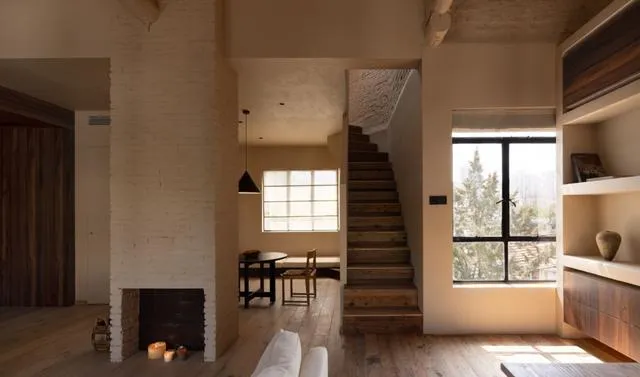

设计理念
Design concept
修旧如旧|Repair as before
拆下原来的青砖让师傅事先保留下来,为后期的壁炉砌砖,用粘土去覆盖的同时,将砖的纹路也保留下来,青砖侧面依稀能看到当时窑厂烧制留下的纹样,顺着楼梯往上,还可以摸到旧的砖墙,触觉上更是赋予这个房子感受时空交换的瞬间,主大厅屋顶的木梁也保留了原先的结构状态,未重新吊顶,高阔的纵深感,将古朴不多加修饰的氛围从另一维度的感官上加强,为此搭配深色混拼的烟熏木,跟黑色拉丝橡木,麻制软布料,得以和谐共生。
The original blue bricks were removed and allowed to be preserved by the master in advance for laying bricks for the later fireplace. While covering them with clay, the texture of the bricks was also preserved. The patterns left by the kiln firing at that time can be seen vaguely on the sides of the green bricks. , going up the stairs, you can also touch the old brick walls, which gives this house a sense of time and space exchange. The wooden beams on the roof of the main hall also retain their original structural state, and have not been re-ceilinged. The high and wide The sense of depth enhances the simple and unadorned atmosphere from another dimension to the senses. For this reason, it is matched with dark mixed smoked wood, black brushed oak, and soft linen fabrics to achieve a harmonious symbiosis.
▼室内主大厅概览,main living hall overview © 李圣高子
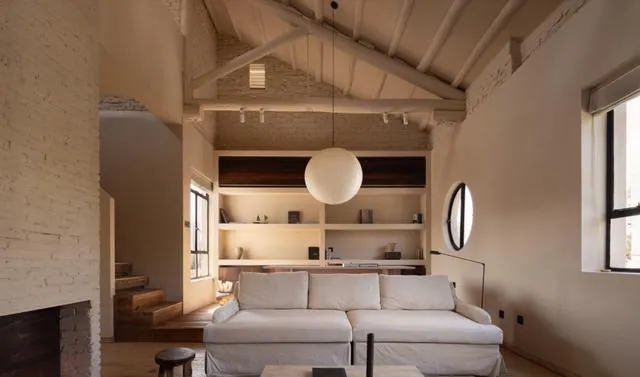
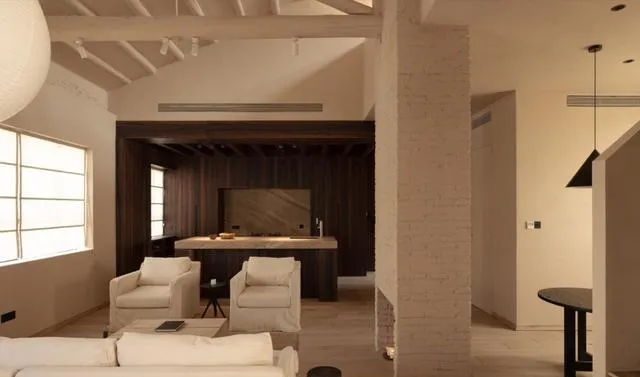
▼窗户的绿意,The green in the window © 李圣高子
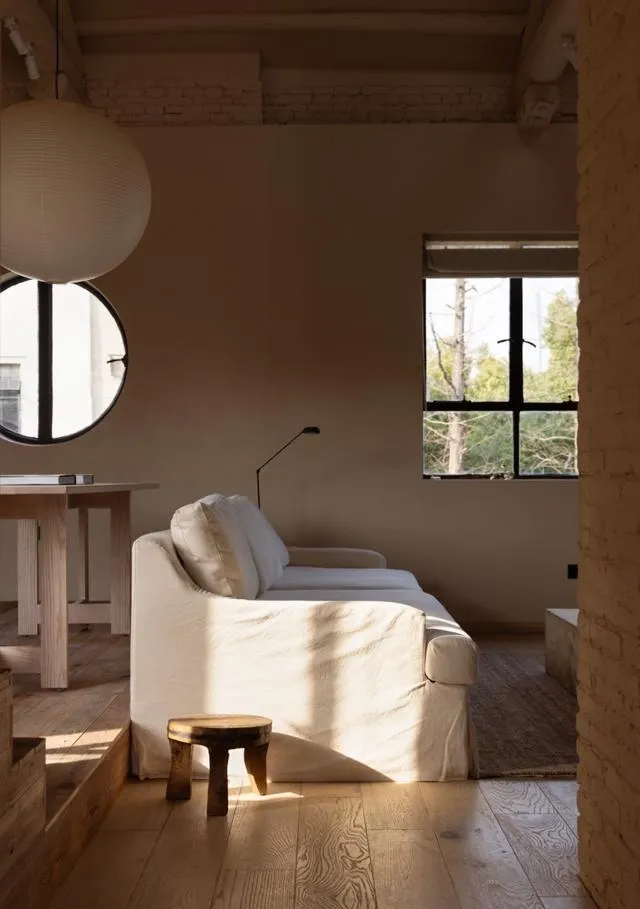
多维度的互动|Multi-dimensional interaction
城市中的边界感给人以自有的约束,而在家里,多场景的区域互动当是有互动,甚至是人人可参与,公区不需要有片墙去阻隔,大空间实现吧台操作区与厨房的互动,客厅与吧台操作的互动,客厅与餐厅的互动,客厅与书房的互动,更有二楼夹层公区与一楼公区的互动,客厅的最末端书桌区域地面与楼梯采用统一木材,以地台的形式链接一楼与二楼,这个高起的地台过渡空间情绪,也是另一种区域划分的形式。
The sense of boundaries in the city gives people their own constraints, but at home, regional interaction in multiple scenes should be interactive, and even everyone can participate. Public areas do not need to be blocked by walls, and large spaces can realize bar operation areas. The interaction with the kitchen, the interaction between the living room and the bar operation, the interaction between the living room and the dining room, the interaction between the living room and the study room, and the interaction between the public area on the second floor mezzanine and the public area on the first floor. The floor and stairs of the desk area at the end of the living room are unified. Wood connects the first and second floors in the form of a platform. This raised platform transitions the mood of the space and is another form of regional division.
▼吧台操作区,bar area © 李圣高子
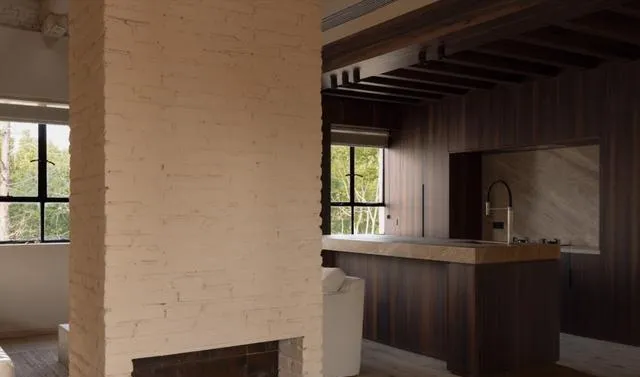
▼从吧台望向卧室,view from kitchen bar towards the bedroom © 李圣高子
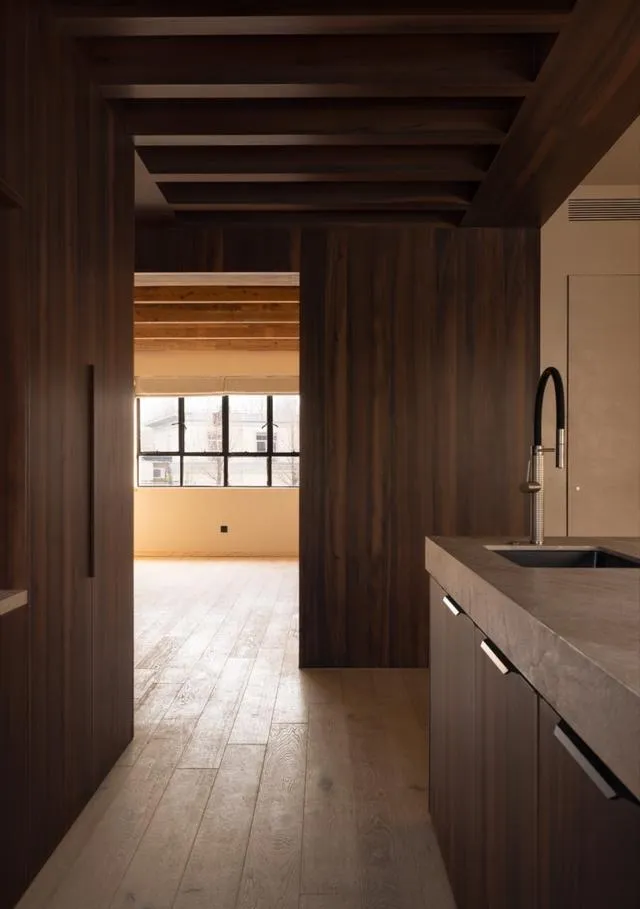
▼从卧室望向吧台,view from the bedroom bar towards the bar © 李圣高子
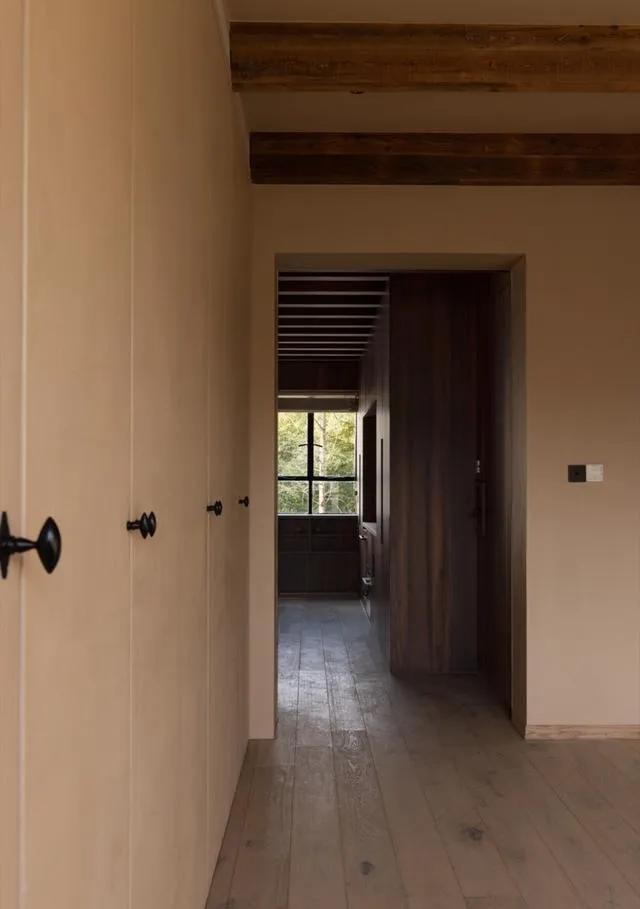
▼一瞥,a glimpse © 李圣高子
▼卧室,bedroom © 李圣高子


光在空间中的角色|The role of light in space
二楼的屋顶开启了几晒天窗,拉长的光影好似空间里的舞者,在增加夹层空间的同时,赋予光的嫁衣,窗外虽处闹市,但在浦西的这块老城区层高都不高,往外只可望见红红的瓦顶及高大的松树,投射进来的光线自然是足够的,且饱满。
Several skylights are opened on the roof of the second floor, and the elongated light and shadow are like dancers in the space. While increasing the mezzanine space, it also gives the wedding dress of light. Although the window is in a busy city, in this old city of Puxi, the skylights are high. It’s not high, and you can only see the red tile roof and tall pine trees. The light coming in is naturally enough and full.
▼夹层空间,the mezzanine space © 李圣高子
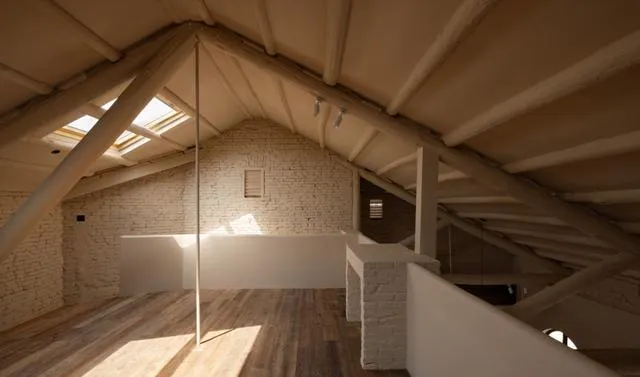
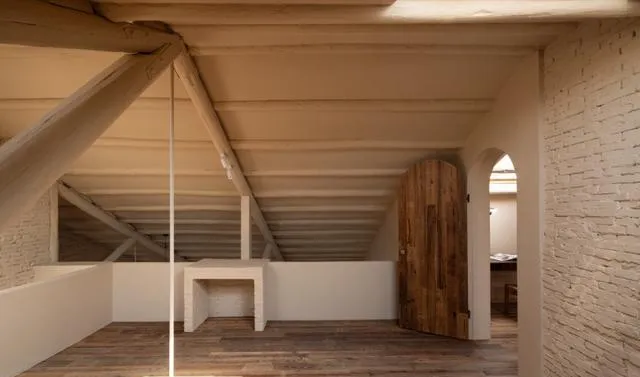
材质运用
Material use
好的居所一定能吸纳人生活的痕迹,从而呈现出特定的丰富性,自然在这种情境下在材质的选择上显现沧桑古色 ,带结巴的原木木地板,酸洗过的砂岩类石材,全屋的实木饰面选用的是苹果木烟熏而成,透明的木蜡油毫不阻隔木材的天然感,包容在黏土质感的墙漆下,整个家气质温和,都源自自然的用色主张最终回归于大地色系的沉稳。充分尊重材质肌理的墙面处理方式,带来光影下的斑驳感,与砖的纹路相互承托使得质感进一步贴近自然。
A good residence must be able to absorb the traces of people’s life, thus showing a specific richness. In this situation, naturally, the vicissitudes of life will appear in the choice of materials, such as stuttering log floors, acid-washed sandstone stones, etc. The solid wood veneer of the house is made of smoked apple wood. The transparent wood wax oil does not block the natural feel of the wood. It is contained under the clay-textured wall paint. The whole home has a gentle temperament, which is derived from the natural color concept. Finally returns to the calmness of earth tones. The wall treatment method that fully respects the material texture brings a mottled feeling under light and shadow, and mutually supports the texture of the bricks, making the texture closer to nature.
▼自然的用色主张最终回归于大地色系的沉稳,a gentle temperament that returns to the calmness of earth tones © 李圣高子

▼楼梯,staircase © 李圣高子
▼尊重材质肌理的墙面处理方式,wall treatment method fully respects the material texture © 李圣高子
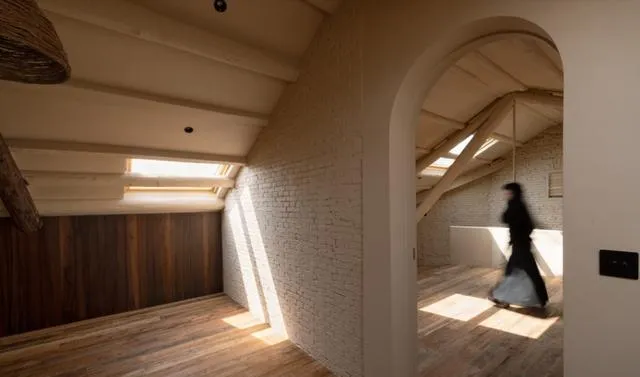
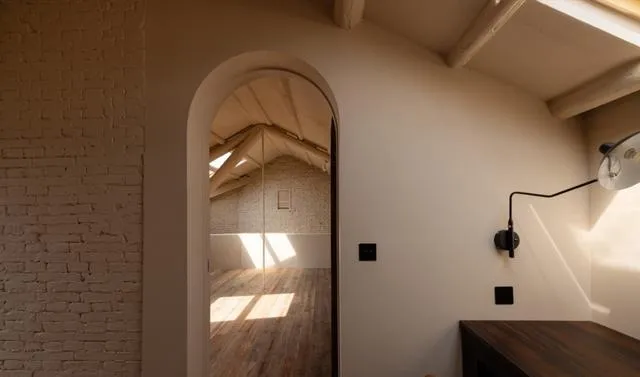
▼书房一角,a corner in the study © 李圣高子
大地色系中,一些黑色单品穿插于空间之内,以沉稳且经典的视觉印象为整个家里的用色增加几许层次感。棉麻也是自然居所的首选材质,刻意选择的通透感窗帘,以更显古意的折叠方式引光入室,沙发与床品借助棉麻的亲肤感,营造生活更为妥帖与自然的形态。人居于此,如回归自然,更如吸附在自然之中。
In the earth tones, some black items are interspersed in the space, adding a sense of layering to the color palette of the entire home with a calm and classic visual impression. Cotton and linen are also the preferred materials for natural residences. The transparent curtains are deliberately selected to bring light into the room with a more ancient folding method. The sofa and bedding use the skin-friendly feeling of cotton and linen to create a more appropriate and natural form of life. . Living here feels like returning to nature, or even more like being absorbed in nature.
▼黑色单品增加几许层次感,some black items adding a sense of layering © 李圣高子
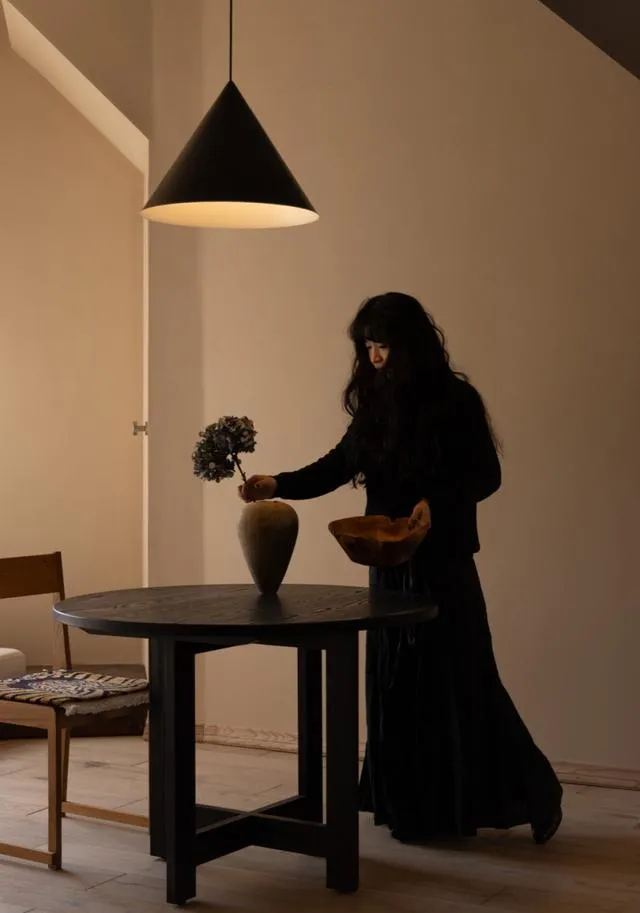

▼家具细节,items detail © 李圣高子
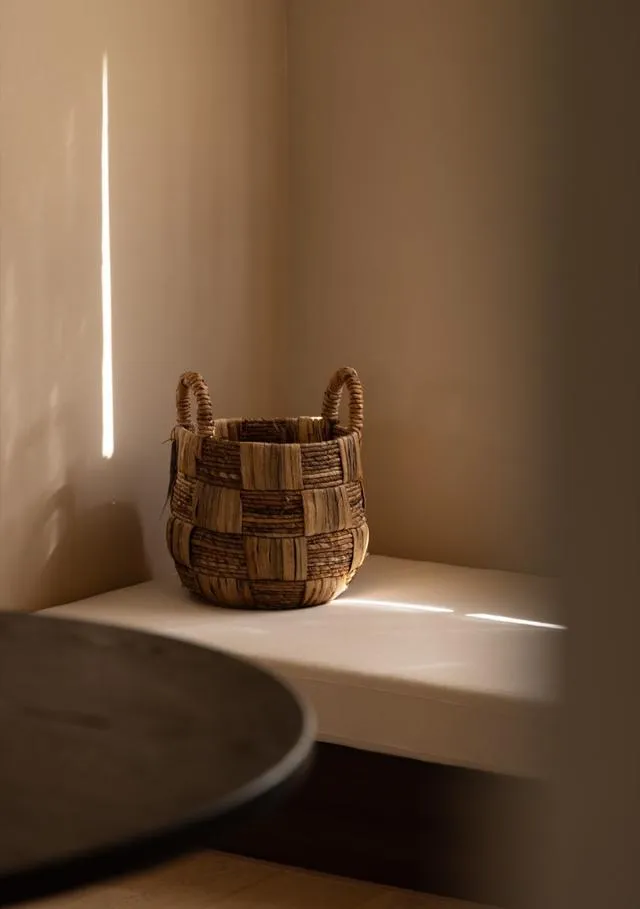
▼改造前平面,existed plan © 游牧林工作室

▼改造后首层平面,1F plan after renovation © 游牧林工作室
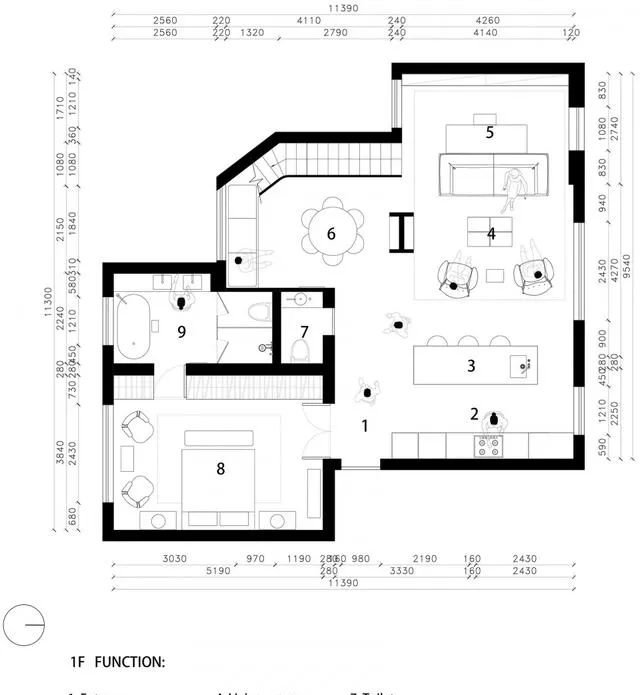
▼改造后二层平面,2F plan after renovation © 游牧林工作室
▼原始剖面,original p © 游牧林工作室
项目名称:湖南路老房改造











